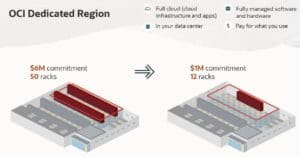This write-up covers Oracle’s OCI announcement, followed by the implications of these new capabilities to customers, competitors, and investors, and a summary.

Figure 1: Oracle’s Distributed Cloud Portfolio.
Source: Oracle
On June 21st,2022, Oracle added the OCI Dedicated Region and a preview of Compute Cloud@Customer services to Oracle’s Distributed Cloud Portfolio (see Figure 1). The on-premises OCI Dedicated Region promises lesser data center space and power with the same benefits as OCI’s public cloud, which benefits customers requiring data residency or low latency. OCI Compute Cloud@Customer targets customers that do not need an environment as large as the OCI Dedicated Region but need a fully managed service with a common control plane across all domains.
In 2016, Oracle Cloud Infrastructure (OCI) launched with a single region and has since expanded to 29 cloud regions. The services offered also increased from computing, storage, and infrastructure to a wide range of capabilities ranging from Kubernetes to databases. Since the launch of Oracle’s public OCI, multi or hybrid cloud demand has grown to meet regulatory and security requirements. Customer expectations for the multi or hybrid cloud require vendors to offer identical public and on-premises services with control from a single pane of glass. This Oracle announcement offers cloud service consumption capabilities that match customer demand for a pay-as-you-go pricing model.

Figure 2: How the Oracle Dedicated Region Delivers Consumption Based Pricing.
Source: Oracle
When OCI Dedicated Region (see Figure 2) and Compute Cloud@Customer is combined with Oracle’s OCI cloud native application development capabilities, customers can concurrently support current applications and extend business agility with application modernization initiatives. In this announcement, Oracle highlighted a financial services customer, a telco customer, and a government customer. However, these offerings will also help health care customers with low latency needs and customers with an international presence following strict regional regulatory restrictions on data residency.
Implications to customers
Oracle customers will benefit when migrating current on-premises offerings to OCI Dedicated Regions with a lower effort. At the same time, customers should consider cloud native technologies to deliver added business agility for future needs. Broadcom announced an agreement to acquire VMware in May 2022 and plans to rebrand the Broadcom Software Group as VMware, according to a press release on June 22, 2022. Regarding the scheduled VMware acquisition by Broadcom, VMware customers should weigh the benefits of replacing vSphere with Oracle Cloud@Customer.
Implications to competitors
The multi or hybrid cloud offerings have increased in the last couple of years, giving customers a variety of capabilities that reduce barriers to cloud adoption. Oracle OCI competitors will have to match these new offerings and provide customers with a consistent experience between on-premises and cloud environments.
Implications to investors
VMware vSphere is prevalent in large enterprises and is used to manage applications across on-premises environments and Oracle’s Public OCI Compute. Exadata Cloud@Customer showed significant year-over-year growth and is often used with VMware vSphere. Oracle Cloud@Customer offers an alternative to current VMware vSphere customers opening a revenue opportunity for Oracle and a challenge for VMware.
Summary
This announcement plugs some gaps in Oracle’s distributed cloud portfolio and is a step in the right direction to meet customer needs. Customers would also benefit from Oracle’s cloud native capabilities as customers develop new applications with modern platforms using multi or hybrid implementations of OCI. With increased skills shortage, Oracle partners could step in and help customers in their application modernization journey using Oracle OCI.
